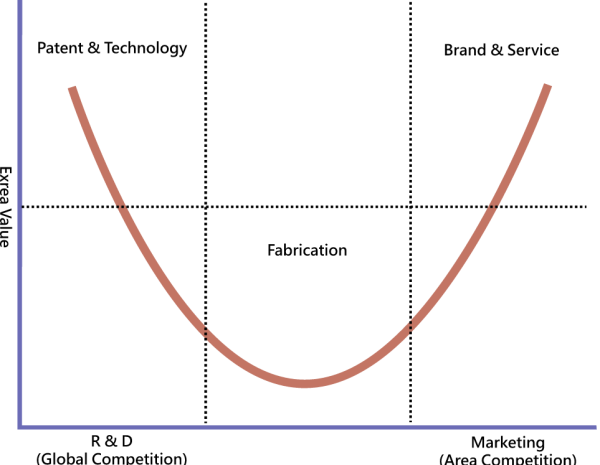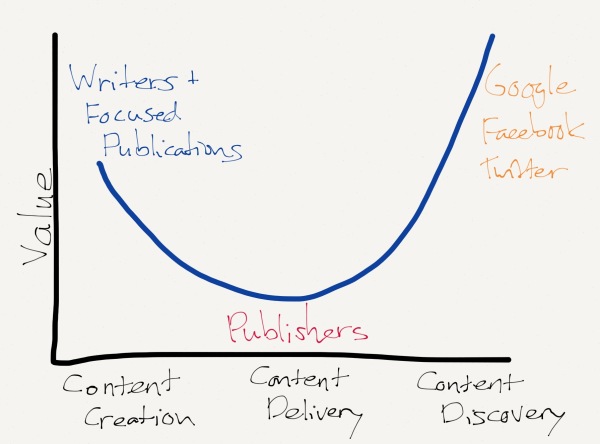The Smiling Curve
 publishers smileFascinating piece by Ben Thompson of Stratechery fame.
publishers smileFascinating piece by Ben Thompson of Stratechery fame.
Stand Stih - founder of Acer talks about what has become to be known as the ‘smiling curve’. His hypothesis is that “value is created at the edges”. For example in his world of PCs - he saw patents and technology driving value at one end of the scale - think Windoze and Intel - and brand and service driving value at the other end - value being driven by (say) SI’s - think Accenture, IBM et al.
Acer meanwhile - as a fabricator of the machines - along with the other OEMs - found themselves in a race to the bottom.
It got Ben to thinking - and I have to say - I like the way it does out … he started to draw a comparison to Publishing.
As you can see from the Smiling curve below - he sees the x axis in three main buckets - with publishers falling into
- content creation : writers / focussed publications
- content delivery : publishers
- content discovery : google. Facebook, twitter et al.
BRILLIANT.
 Rechenschieber5
Rechenschieber5
Of course - back in the day publishers handled the whole enchilada. They owned the journalists and editors, the printing presses - and the paper boy who cycled around depositing the news papers onto drives or into letter boxes. I wonder if this is where the problem started ? Kind of like the (now classic) Faber Castell case study …. Newspapers thought they were in the content delivery business - not the information provision business …. to save you the click through - Faber Castell through they made slide rules - not things to help people calculate stuff. The image to the left is one of their products from 1974, and the slide market disappeared over night (1975). Who would have thought ? Ummm … Clive Sinclair for one !
So, back to Publishing …. as time passed - content delivery moved away to specialists. News became commoditized (separate topic - I have always thought that nobody should EVER pay for news - they SHOULD pay for commentary, analysis and that unique value that differentiates one writer / publication from another …. but as I say - separate topic) … and the delivery mechanism gets replaced by Social. (Don’t get me started on that one - speaking as someone that has just exited from Facebook - and continues with RSS - I do think we are handing far too much control over to ‘the masses’ - but as David Byrne once quipped - ‘Same as it ever was’.
I think Ben’s insights here are truly insightful. And supports a recent meme of mine that the Publishing industry is bifurcated - not irreparably - but bifurcated none the less between those Publishing houses that ‘get it’ - and those that don’t. The ‘it’ is the new world where Micro-payments will begin to take a role (my money is on Apple-Pay being the first to do that BTW) - large firewalled gardens of content run by Newspaper barons will not work. BUT - focussed, insightful, highly relevant content ? Yup - that will be there. We used to read the New York Times - not for the news - but for the opinion, the insight, the commentary, the editorial, the thought … newspapers today GENERALLY don’t have that - at least not at there level that convinces people to part with lots of cash. Instead we co through to specific people that we like and watch and track - and read their opinion - we don’t need the brand name to give us confidence that we should trust the writer. We know who the writer is.

